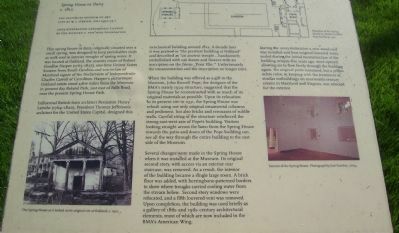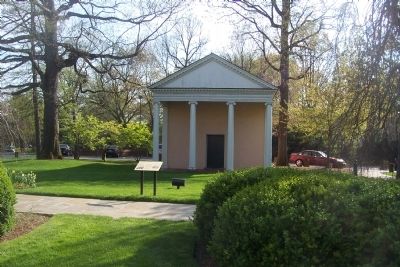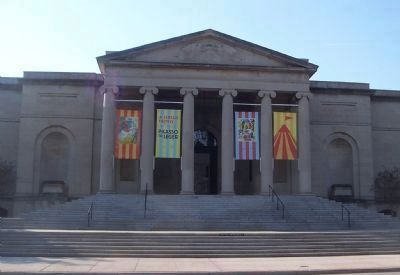Johns Hopkins Homewood in Baltimore, Maryland — The American Northeast (Mid-Atlantic)
Spring House or Dairy - c. 1812
The Baltimore Museum of Art
The spring house or dairy, originally situated over a small spring, was designed to keep perishables such as milk cool in interior troughs of spring water. It was located at Oakland, the country estate of Robert Goodloe Harper (1765-1827), one-time United States Senator from South Carolina and son-in-law of Maryland signer of the Declaration of Independence Charles Carroll of Carrollton. Harper’s picturesque Oakland estate stood a few miles from the Museum in present day Roland Park, just east of Falls Road near the present Spring House Path.
Influential British-born architect Benjamin Henry Latrobe (1764-1820), President Thomas Jefferson’s architect for the United States Capital, designed this neo-classical building around 1812. A decade later it was praised as the “prettiest building in Oakland” and described as an “ancient temple...handsomely embellished with oak trees and flowers with an inscription on the frieze, ‘Pour Elle.’” Unfortunately, the ornamentation and the inscription no longer exist.
When the building was offered as a gift to the Museum, John Russell Pope, the designer of the BMA’s stately 1929 structure, suggested the Spring House be reconstructed with as much of its original materials as possible. Upon its relocation to its present site in 1931, the Spring House was rebuilt using not only original columns and pediments, but also bricks and remnants of rubble walls. Careful siting of the structure reinforced the strong east-west axis of Pope’s building. Visitors looking straight across the lawn from the Spring House towards the patio and doors of the Pope building can see all the way through the entire building to the east side of the Museum.
Several changes were made in the Spring House when it was installed at the Museum. Its original second story, with access via an exterior rear staircase, was removed. As a result, the interior of the building became a single large room. A brick floor was added, with herringbone-patterned borders to show where troughs carried cooling water from the stream below. Second story windows were relocated, and a fifth louvered vent was removed. Upon completion, the building was used briefly as a gallery of 18th- and 19th- century architectural elements, most of which are now included in the BMA’s American Wing.
During the 2003 restoration, a new wood roof was installed and for original louvered vents, sealed during the initial reconstruction seventy-five years ago, were opened, allowing air to flow freely through the building again. No original paint remained, but a yellow ochre color, in keeping with the treatment of similar out-buildings in nineteenth-century estates in Maryland and Virginia, was selected for the exterior.
(Gift of Benjamin B. O’Brien, BMA, 1932.25.1.
2003 Restoration generously funded by Richard C. Von Hess Foundation.)
[Illustrations:]
Floorplan of the Spring House in relation to BMA Pope Building of 1931.
The Spring House as it looked on its original site in Oakland, c. 1931. Interior of the Spring House. Photographed by Jose Sanchez, 2003.
Erected 2003 by Baltimore Museum of Art.
Topics. This historical marker is listed in these topic lists: Arts, Letters, Music • Education • Waterways & Vessels. A significant historical year for this entry is 1812.
Location. 39° 19.508′ N, 76° 37.206′ W. Marker is in Baltimore, Maryland. It is in Johns Hopkins Homewood. Marker can be reached from Art Museum Drive north of Wyman Park Drive. Marker is on the grounds of the Baltimore Museum of Art, accessible to pedestrians off the garden path between the Spring House and the BMA Pope Building, just north of the Art Museum Drive/Wyman Park Drive intersection. Touch for map. Marker is at or near this postal address: 10 Art Museum Drive, Baltimore MD 21218, United States of America. Touch for directions.
Other nearby markers. At least 8 other markers are within walking distance of this marker. Lion (within shouting distance of this marker); Harriet Tubman Grove (about 300 feet away, measured in a direct line); Chapin A. Harris
(about 300 feet away); Joseph Beuys Tree Partnership (about 300 feet away); Wyman Park Dell (about 500 feet away); William Henry Welch (about 600 feet away); Daniel Coit Gilman (about 600 feet away); The 1958 Johns Hopkins University Commencement (about 600 feet away). Touch for a list and map of all markers in Baltimore.
Also see . . . Baltimore Museum of Art. (Submitted on April 26, 2009, by Richard E. Miller of Oxon Hill, Maryland.)
Credits. This page was last revised on February 20, 2021. It was originally submitted on April 26, 2009, by Richard E. Miller of Oxon Hill, Maryland. This page has been viewed 1,718 times since then and 30 times this year. Photos: 1, 2, 3. submitted on April 26, 2009, by Richard E. Miller of Oxon Hill, Maryland. • Bill Pfingsten was the editor who published this page.


